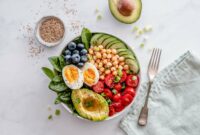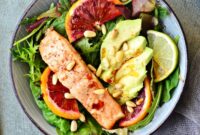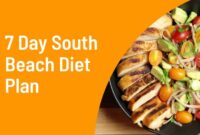South Beach prepared meals offer a convenient and delicious way to adhere to the popular South Beach Diet. This guide delves into the specifics of meal preparation, ingredient sourcing, and recipe ideas, providing a comprehensive resource for anyone looking to simplify their South Beach journey. We’ll explore the diet’s phases and how prepared meals fit within each, offering tips for maximizing nutritional value and minimizing effort.
From understanding macronutrient ratios and choosing appropriate cooking methods to selecting high-quality ingredients and managing costs, we’ll cover all the essential aspects of successfully incorporating prepared meals into your South Beach lifestyle. We’ll also provide practical advice on meal planning, storage, and even the visual appeal of creating a balanced and appetizing plate.
South Beach Diet Compatibility
South Beach Diet prepared meals offer a convenient way to adhere to the diet’s principles, which focus on controlling carbohydrate intake and prioritizing healthy fats and lean proteins. Understanding the different phases of the South Beach Diet is crucial for selecting appropriate prepared meals. This section details the macronutrient ratios for each phase and provides examples of compatible meal options.
South Beach Diet Phases and Macronutrient Ratios
The South Beach Diet is structured in three phases, each with specific dietary guidelines and macronutrient targets. Understanding these ratios is key to successful weight management and overall health. While exact ratios can vary based on individual caloric needs, the general guidelines are as follows:
| Phase | Carbohydrates | Protein | Fat |
|---|---|---|---|
| Phase 1 (Induction) | Very Low (primarily from non-starchy vegetables) | Moderate to High | Moderate |
| Phase 2 (Weight Loss) | Gradual increase, focusing on good carbohydrates | Moderate to High | Moderate |
| Phase 3 (Maintenance) | Increased variety of carbohydrates, including whole grains | Moderate | Moderate |
Prepared Meal Alignment with South Beach Diet Phases
Prepared meals can significantly simplify adherence to the South Beach Diet. Careful selection based on ingredient lists and nutritional information is essential for staying within the guidelines of each phase.
Phase 1 (Induction) Compatible Prepared Meals
Phase 1 emphasizes very low carbohydrate intake, focusing on lean proteins and healthy fats. Suitable prepared meals would include dishes like grilled chicken breast with steamed asparagus and a small portion of olive oil, or salmon with a side salad featuring leafy greens and a vinaigrette dressing. These meals avoid high-glycemic index carbohydrates like bread, pasta, and sugary fruits.
Phase 2 (Weight Loss) Compatible Prepared Meals
Phase 2 introduces a gradual increase in good carbohydrates. Prepared meals could incorporate lean proteins such as turkey breast, chicken, or fish, combined with non-starchy vegetables and small portions of whole grains like quinoa or brown rice. An example would be a chicken and vegetable stir-fry with brown rice, or a lentil soup with a side salad.
Phase 3 (Maintenance) Compatible Prepared Meals
Phase 3 allows for a wider variety of carbohydrates, including whole grains and fruits. Prepared meals could include dishes like baked chicken with sweet potato and green beans, or a turkey and avocado sandwich on whole-wheat bread. Portion control remains important even in this phase.
Nutritional Comparison of South Beach-Friendly Prepared Meals
The following table provides a sample comparison of the nutritional content of various South Beach-friendly prepared meals. Note that these are examples and actual values may vary depending on the specific recipe and serving size.
| Meal | Calories | Protein (g) | Carbohydrates (g) | Fat (g) |
|---|---|---|---|---|
| Grilled Chicken & Asparagus | 350 | 35 | 10 | 15 |
| Salmon with Salad | 400 | 30 | 15 | 25 |
| Chicken Stir-fry with Brown Rice | 450 | 30 | 40 | 15 |
| Turkey & Avocado Sandwich (Whole Wheat) | 420 | 35 | 45 | 18 |
Meal Preparation Styles and Methods
Preparing South Beach Diet meals involves a variety of cooking techniques that prioritize nutrient retention and delicious flavor profiles. The key is to select methods that minimize the loss of vitamins and minerals while enhancing the natural tastes of the ingredients. This section will explore several popular methods and their impact on your meals.
Grilling
Grilling offers a quick and flavorful way to cook lean proteins and vegetables. The high heat creates a delicious char and enhances the natural flavors. However, some nutrient loss can occur through dripping juices. To minimize this, use a grill basket for smaller vegetables and avoid overcooking. Grilling is ideal for lean meats like chicken breast, fish, and certain vegetables such as bell peppers and zucchini. The smoky char adds a unique taste dimension that complements the South Beach Diet’s emphasis on fresh, flavorful ingredients.
Steaming
Steaming is a gentle cooking method that preserves the maximum amount of nutrients. It involves cooking food using the steam produced by boiling water. This method is particularly suitable for delicate vegetables like broccoli, asparagus, and green beans, as it prevents overcooking and maintains their vibrant color and crisp texture. While steaming might not add the same level of intense flavor as grilling, it results in healthy, nutrient-rich side dishes that perfectly complement a South Beach meal.
Baking
Baking provides a versatile method for preparing a wide range of South Beach-compliant meals. It’s ideal for roasting vegetables, baking fish, and creating lean protein dishes. Baking often requires less added fat than other methods, contributing to the diet’s low-fat principles. The controlled heat ensures even cooking and helps retain moisture, resulting in tender and flavorful dishes. For example, baking salmon with herbs and lemon creates a healthy and satisfying meal.
Sample Weekly Meal Plan Incorporating Diverse Preparation Methods
A balanced weekly meal plan should incorporate variety in both ingredients and preparation methods. The following is a sample plan, and portion sizes should be adjusted to individual needs and caloric goals:
Monday: Grilled chicken breast salad with steamed broccoli and a light vinaigrette.
Tuesday: Baked salmon with roasted asparagus and a side of quinoa.
Wednesday: Steamed shrimp with zucchini noodles and a lemon-herb sauce.
Thursday: Grilled lean steak with a side salad and steamed green beans.
Friday: Baked chicken breast with roasted sweet potatoes and a small portion of brown rice.
Saturday: Grilled portobello mushrooms with a mixed green salad and a light dressing.
Sunday: Baked cod with steamed carrots and a side of cauliflower mash.
Essential Kitchen Tools and Equipment
Having the right tools significantly simplifies the process of preparing South Beach-compliant meals. Investing in a few key items will make meal preparation efficient and enjoyable.
The following list includes essential items:
- Non-stick skillet
- Baking sheet
- Steamer basket
- Grill pan or outdoor grill
- Measuring cups and spoons
- Sharp knife
- Cutting board
- Food processor (optional, but helpful for quick chopping)
Recipe Ideas and Variations
South Beach Diet-friendly prepared meals offer a wide array of delicious and nutritious options. The key is focusing on lean protein, healthy fats, and non-starchy vegetables while limiting refined carbohydrates and sugars. The following recipes provide diverse and adaptable meal choices, perfect for meal prepping and adhering to the South Beach Diet’s principles.
Mediterranean Quinoa Salad
This vibrant salad is packed with flavor and nutrients, perfect for a light lunch or dinner.
- Ingredients: 1 cup cooked quinoa, 1 cup chopped cucumber, 1/2 cup chopped tomatoes, 1/2 cup crumbled feta cheese, 1/4 cup Kalamata olives, 2 tablespoons olive oil, 1 tablespoon lemon juice, salt and pepper to taste.
- Instructions: Combine cooked quinoa, cucumber, tomatoes, feta cheese, and olives in a large bowl. In a small bowl, whisk together olive oil, lemon juice, salt, and pepper. Pour dressing over the salad and toss gently to combine. Serve chilled.
- Dietary Adaptations: For a vegetarian option, simply omit the feta cheese. For a gluten-free version, ensure your quinoa is certified gluten-free (though quinoa is naturally gluten-free).
Lemon Herb Baked Salmon with Asparagus
This recipe offers a healthy and satisfying dinner option, rich in omega-3 fatty acids and fiber.
- Ingredients: 2 salmon fillets (6-8 oz each), 1 bunch asparagus, 1 lemon (sliced), 2 tablespoons olive oil, 1 tablespoon dried herbs (Italian mix or your preference), salt and pepper to taste.
- Instructions: Preheat oven to 400°F (200°C). Place asparagus on a baking sheet. Drizzle with 1 tablespoon olive oil, salt, and pepper. Place salmon fillets on the same baking sheet. Drizzle with remaining olive oil, herbs, salt, and pepper. Top each fillet with lemon slices. Bake for 12-15 minutes, or until salmon is cooked through and asparagus is tender-crisp.
- Dietary Adaptations: This recipe is naturally gluten-free. For a variation, substitute other vegetables like broccoli or green beans for the asparagus.
Chicken and Vegetable Stir-Fry
This quick and easy stir-fry is a great option for a weeknight meal, offering a balanced combination of protein and vegetables.
- Ingredients: 1 lb boneless, skinless chicken breast (cut into bite-sized pieces), 1 cup broccoli florets, 1 cup sliced bell peppers (any color), 1/2 cup sliced onions, 2 tablespoons soy sauce (low sodium), 1 tablespoon sesame oil, 1 teaspoon ginger (minced), garlic powder to taste.
- Instructions: Heat sesame oil in a large skillet or wok over medium-high heat. Add chicken and cook until browned. Add broccoli, bell peppers, and onions; stir-fry for 5-7 minutes, or until vegetables are tender-crisp. Stir in soy sauce, ginger, and garlic powder. Cook for another minute, or until heated through. Serve immediately.
- Dietary Adaptations: For a vegetarian option, substitute chicken with firm tofu. To make it gluten-free, use tamari or coconut aminos instead of soy sauce. For a spicier kick, add a pinch of red pepper flakes.
Cost and Convenience Factors
The decision of whether to prepare South Beach Diet meals at home or purchase pre-made options hinges significantly on individual circumstances, including budget, available time, and culinary skills. A thorough cost-benefit analysis, considering both financial and time investments, is crucial for making an informed choice.
The cost-effectiveness of preparing South Beach meals at home versus purchasing prepared meals varies greatly. Generally, homemade meals tend to be more budget-friendly, particularly in the long run. However, the initial investment in groceries and the time spent shopping, preparing, and cooking must be factored into the equation. Pre-made meals offer convenience but often come with a higher price tag, reflecting the added costs of preparation, packaging, and delivery.
Cost Comparison: Homemade vs. Prepared Meals
Preparing South Beach meals at home usually results in lower overall costs. For example, a homemade chicken breast with steamed vegetables might cost around $3-$5, while a comparable prepared meal could easily cost $10-$15 or more. The savings become more pronounced over time, especially for individuals following the diet long-term. However, the initial grocery shopping expense might be higher upfront, and some individuals might find the cost of specialized South Beach-friendly ingredients to be a barrier. The convenience of prepared meals, however, can offset some of the cost difference for those with limited time or cooking skills.
Convenience and Time Savings
Prepared meals offer unparalleled convenience, eliminating the need for grocery shopping, meal planning, cooking, and cleanup. This is particularly beneficial for busy individuals, those with limited culinary skills, or those who travel frequently. The time saved can be significant; instead of spending an hour or more preparing a meal, a prepared meal can be ready in minutes. Conversely, homemade meals require dedicated time for preparation, which can be a significant drawback for those with demanding schedules.
Time Savings with Prepared Meals
A typical workday might involve an hour or more spent on meal preparation, including shopping, cooking, and cleaning. Using prepared meals can reduce this time significantly, potentially freeing up several hours per week. This time can be used for other activities, such as exercise, work, or spending time with family and friends. However, the time saved needs to be weighed against the potential higher cost of pre-made options.
Budget-Friendly South Beach Meal Plan
A balanced approach, incorporating both homemade and prepared meals, can offer the best of both worlds. A sample budget-friendly plan might include:
* Homemade: Breakfasts (e.g., overnight oats with berries and nuts) and lunches (e.g., large batch of chicken salad or tuna salad for several days) can be cost-effective and prepared in advance.
* Prepared Meals: Dinners (1-2 per week) might utilize pre-made options, especially on particularly busy days. Choosing less expensive prepared meals or opting for larger portions to split over multiple days can help control costs.
This strategy allows for both cost savings and time efficiency, catering to individual needs and budget constraints. Careful planning and mindful purchasing are key to success.
Visual Representation of Meals
The visual appeal of a South Beach prepared meal is crucial for maintaining adherence to the diet. A visually appealing meal encourages enjoyment and satisfaction, making it easier to stick to the plan. The colors, textures, and overall presentation significantly impact the perception of the meal’s healthiness and deliciousness.
A well-presented South Beach meal should be vibrant and enticing. The strategic use of color, texture, and plating techniques can transform a simple dish into a culinary masterpiece that satisfies both the palate and the eye. This section will explore how visual elements contribute to a healthy and appetizing meal presentation within the South Beach Diet framework.
South Beach Plate Composition
Imagine a vibrant plate featuring grilled salmon, its pink hue contrasting beautifully with the deep green of asparagus spears and the sunny yellow of roasted bell peppers. A small portion of quinoa, providing a neutral beige tone, adds a textural element and completes the balanced meal. The salmon is flaky and moist, the asparagus crisp-tender, and the peppers slightly caramelized, offering a variety of textures. The quinoa provides a hearty base, complementing the other elements. The entire plate is arranged artfully, not crowded, allowing each component to stand out. This balanced presentation immediately conveys the meal’s healthiness and deliciousness, showcasing the variety of nutrients and flavors. The careful arrangement of the components on the plate makes the meal appear both appetizing and sophisticated, encouraging mindful eating and enhancing the overall dining experience.
Final Conclusion
Ultimately, embracing South Beach prepared meals allows for a flexible and sustainable approach to healthy eating. By understanding the principles of the diet, utilizing efficient preparation techniques, and selecting high-quality ingredients, you can create delicious and nutritious meals that align perfectly with your dietary goals. This guide provides the tools and information necessary to make the South Beach Diet a manageable and enjoyable experience, regardless of your culinary skill level or time constraints.




